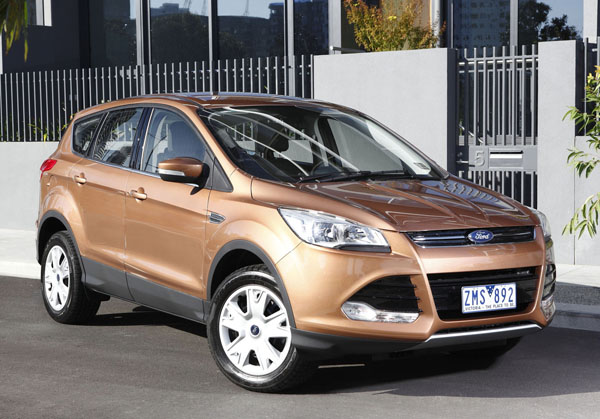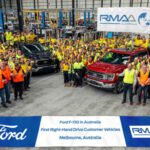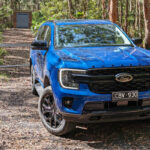Ford Kuga belongs to an increasingly large class of vehicles that are marketed as SUVs, but are in fact tall hatchbacks with either no off-road ability or, at best, the ability to be driven on dirt tracks and the like.
The big appeal of Kuga and others is that they provide added space, are easier to get in and out of, have a (slightly) higher driving position and – let’s come straight to the point here – have a tougher look than conventional hatchbacks.
Some Kugas have two-wheel-drive (the front wheels), others do have the added traction of all-wheel-drive.
Realising the leap in sale of cars in the Kuga class Ford Australia was forced to get in earlier than initially planned, importing a model that had been on sale in Europe for four years before it reached us downunder in February 2012.
That first Kuga was discontinued here in April 2013 and replaced by one that was virtually all-new.
More interior space, particularly in the rear seats, makes the gen-two Kuga the more attractive proposition for family buyers. Not only do the rear seats provide more legroom, their backs recline over a 10-degree range, allowing you to juggle between luggage and passenger space. The rear seats fold flat in a single movement. Also, the rear occupants can adjust the seatbacks to their wishes. The latter is a nice feature that’s often only found in far more expensive cars.
Road and wind noise in the 2013 Kuga have been significantly reduced to help deliver one of the quietest cabins in the segment.
All-in-all, the second generation Ford Kuga is the one to opt for if your budget is up to it. It’s significantly better in so many ways than its five year old brother.
Perhaps to compensate for its late arrival the first Kuga was only imported in its upmarket variants that were powered by a pretty hot 2.5-litre turbo-petrol engine with 147 kW of power, which is related to the hot Focus RS. It’s a bit of a gas guzzler, but great fun to sit behind.
The new model Kuga of 2013 had a 2.0-litre turbo-diesel, it was replaced by a new design diesel at the end of 2014. A 1.6-litre EcoBoost turbo-petrol in two states of tune was the bigger seller. In January 2015 the 1.6 engines were replaced by a 1.5 or 2.0-litre units. Again, the later the engine the more performance it gives you, and the less fuel it consumes.
There is a six-speed manual transmission in the lowest-cost Kuga models with front-drive only. Others have a six-speed automatic transmission.
Ride comfort is pretty good and the Kuga has no trouble coping with most rough Aussie roads. However, the suspension travel isn’t always long enough to cope with really bad roads and there can be some bottoming out.
Handling is very good in the original series Kuga, and even better in the second generation. Definitely a car for the family guys and gals who enjoy their time behind the wheel.
At the time the gen-two Kuga was the first Ford vehicle in Australia to feature Emergency Assistance (EA) across the range. Ford’s Sync system works in conjunction with the driver’s paired smart phone. On detecting airbag deployment or activation of the emergency fuel shut-off, Emergency Assist uses the on-board GPS locator and Bluetooth-paired device to make an emergency call, providing GPS co-ordinates to emergency services.
Ford has been in Australia just about forever and has dealerships all over the country, even in very remote areas. Not all of the outlying ones will have spare parts for Kugas, but can generally have them freighted in within a couple of business days.
Kuga is relatively easy to work on, but as with all modern cars there are complex areas that should only be handled by professional mechanics. Never interfere with any parts that may affect safety unless you know what you’re doing.
Insurance costs are generally about average for this burgeoning class. Premiums have settled to the stage where they are similar from company to company. Shop around by all means, but keep in mind it’s better to build up a good history with one insurer than to save a few dollars by shifting from year to year.
WHAT TO LOOK FOR
Kuga is pretty well built, though not to the high standard of its Korean and Japanese competitors.
Have a good look inside the cabin and boot for parts that don’t fit correctly and/or have been damaged by crabby kids kicking things.
During your test drive listen for squeaks and rattles from interior bits that are in competition with one another for space.
Off-road use in unlikely, but some adventurous souls may have taken all-wheel-drive Kugas onto dirt tracks and forest trails, perhaps even had a go at beach driving. Look underneath for signs of damage, serious mud and dirt, even sand.
Scratches on the doors and bumpers area other signs a Kuga has tackled the Aussie bush.
Check the engine starts promptly and idles smoothly from the moment it kicks over.
Transmissions should be fuss-free and automatic changes should be all-but impossible to hear and feel.
CAR BUYING TIP
Insurance charges can vary a lot on cars that don’t sell in large numbers, so it pays to shop around. When doing so make sure your comparisons are accurate.














